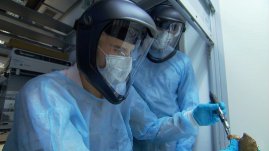Teachers' Domain - Digital Media for the Classroom and Professional Development
User: Preview

Source: The Human Spark: "Becoming Us"




Major funding for The Human Spark is provided by the National Science Foundation, and by the Alfred P. Sloan Foundation. Additional funding is provided by the John Templeton Foundation, the Cheryl and Philip Milstein Family, and The Winston Foundation.
ALAN ALDA (NARRATION) Svante Pääbo heads a project that aims to decipher the entire genetic code of the Neanderthals so that it can be directly compared with our own. Dressed from head to foot in protective clothing, I got to watch how researcher Adrian Briggs drills into Neanderthal bones in search of the tiny fragments of DNA that have survived there.
ALAN ALDA You seem to be taking enormous precautions against contamination. Why is that?
ADRIAN BRIGGS Well, there’s very, very small amounts of DNA left in these bones after so many years in the ground. The amount of DNA that we would normally give off by shedding skin cells for example is the same or more than the amount of actual DNA from the Neanderthal. So in order to really reduce that background DNA then we really have to be as careful as possible. And even then you have to really carefully analyze your results to be sure that you haven’t just sequenced yourself.
ALAN ALDA (NARRATION) The Max Planck team recently completed the first rough draft of the Neanderthal genome. The headline news is that there’s little evidence our ancestors and Neanderthals mated when they met – or at least that they produced any offspring. But so far there is no single genetic smoking gun to explain why the Spark failed to ignite in Neanderthals – in large part because the genetic differences between us and them are turning out to be very, very small.
ALAN ALDA But that small difference between us could be crucial, could mean a great deal about language and thought processes and that kind of thing?
SVANTE PÄÄBO Yes. So the dream is of course to find those few changes that hide in there, that are crucial.
 Loading Standards
Loading Standards